#Magnetic Sensors Market
Explore tagged Tumblr posts
Text
Neuromarketing: how brands are manipulating your brain?
A process called neuromarketing blends marketing with neuroscience. Also discusses how consumer behavior is impacted by the marketing system and how the human brain responds to it. It influences consumer behavior, feelings, and decision-making. It examines how the brain processes and reacts to marketing-related stimuli like branding, packaging, and product design. To learn how the brain reacts to various marketing stimuli, neuromarketing strategies can utilize eye tracking, biometric tests, and brain imaging instruments like fMRI and EEG.



#Neuromarketing:how brands are manipulating your brain#Neuromarketing#Importance of neuromarketing#What are the neuromarketing techniques#What are the objectives of neuromarketing#Functional Magnetic Resonance Imaging (fMRI)#Electroencephalogram (EEG)#Eye tracking#Biometric sensors#The Implicit Association Test (IAT)#Understanding consumer behavior#Improving product design#Enhancing brand perception#Increasing advertising effectiveness#Maximizing customer satisfaction#benefits of neuromarketing#marketing#neuro#what is neuromarketing#neuromarketing tips#neuromarketing reviews#neuromarketing summary
2 notes
·
View notes
Text
Driving Innovation: The Rise of the Magnetic Sensor Market
Driving Innovation: The Rise of the Magnetic Sensor Market
The global Magnetic sensor market is experiencing a surge in demand, driven by advancements in technology and increasing integration across various industries. According to a new report by Straits Research, the market size was valued at USD 3.24 Billion in 2024 and is projected to reach USD 5.60 Billion by 2033, exhibiting a healthy Compound Annual Growth Rate (CAGR) of 6.4% during the forecast period (2025-2033).

The Magnetic Sensor Market encompasses a diverse range of technologies used to detect and measure magnetic fields. These sensors are crucial components in various applications across industries, including automotive, consumer electronics, industrial automation, and healthcare. Key drivers of market growth include advancements in sensor technology, the rise of automation and robotics, and the increasing demand for safety and security features in various applications.
Request Sample Link:https://straitsresearch.com/report/magnetic-sensor-market/request-sample
Magnetic Sensors: A Vital Component Across Industries
Magnetic sensors play a critical role in detecting and measuring magnetic fields. These versatile devices are utilized in a wide range of applications, including:
Automotive: Airbag deployment, anti-lock braking systems (ABS), electronic stability control (ESC), position and speed sensing for motors, and navigation systems.
Consumer Electronics: Smartphones (magnetometers for compass function), tablets, laptops (lid open/close detection), wearables, and gaming controllers.
Industrial: Industrial automation, robotics, process control, security systems, and non-destructive testing.
Other Applications: Aerospace and defense, healthcare (medical devices), and building automation.
Key Drivers Fueling Market Growth
Several significant factors are contributing to the expansion of the magnetic sensor market:
Technological Advancements: The development of new magnetic sensor technologies with enhanced sensitivity, accuracy, and miniaturization is driving their adoption across various applications.
Rise of Automation and Robotics: The increasing automation trend in manufacturing and the growing adoption of robots in various industries are fueling the demand for magnetic sensors for precise positioning and control.
Smart Device Revolution: The proliferation of smart devices with advanced functionalities like navigation, gesture recognition, and security features is propelling the need for magnetic sensors for accurate operation.
Focus on Safety and Security: The rising demand for enhanced safety and security in vehicles and buildings is driving the utilization of magnetic sensors in safety systems and intrusion detection.
Market Segmentation Offers Insights for Strategic Growth
The Straits Research report provides a comprehensive segmentation analysis of the magnetic sensor market, allowing for a deeper understanding of market dynamics:
By Technology:
Hall Effect: This dominant technology offers a cost-effective and reliable solution for various applications.
Anisotropic Magnetoresistance (AMR): AMR sensors offer high sensitivity and are ideal for high-precision applications.
Giant Magnetoresistance (GMR): GMR sensors are known for their high sensitivity and low power consumption, making them suitable for advanced applications.
Tunnel Magnetoresistance (TMR): TMR sensors offer the highest sensitivity among the mentioned technologies but are currently limited by higher costs.
Others: This segment includes emerging technologies like Spin Valve sensors and Magneto-Electric sensors offering unique advantages.
By Range:
1 microgauss: These ultra-low range sensors are used for sensitive measurements in scientific research and medical applications.
1 microgauss–10 gauss: This mid-range segment caters to a wide range of applications, including electronic compasses and consumer electronics.
10 gauss: High-range sensors are employed in industrial applications for current sensing and motor control.
By Application:
Automotive: The largest application segment, driven by the increasing demand for safety and advanced driver-assistance systems (ADAS) features.
Consumer Electronics: Growing at a significant rate due to the integration of magnetic sensors in smartphones, tablets, and wearables.
Industrial: A vital segment due to the need for precise positioning and control in automation processes.
Others: This segment encompasses applications in aerospace and defense, healthcare, and building automation.
By End User:
Consumer Electronics: A prominent end-user segment driven by the rising sales of smartphones and other smart devices.
Automotive: A major end user due to the crucial role of magnetic sensors in vehicle safety and performance.
Industrial: A significant end-user segment adopting magnetic sensors to enhance automation and efficiency.
Aerospace and Defense: Utilizes magnetic sensors for navigation, guidance, and control systems in aircrafts and missiles.
Healthcare: Employs magnetic sensors in medical devices for various diagnostic and therapeutic applications.
Others: This segment includes applications in building automation, security systems, and non-destructive testing.
Competitive Landscape: Leading Players in the Magnetic Sensor Market
The global magnetic sensor market is characterized by a mix of established players and emerging companies. Some of the key players include:
Analog Devices
Amphenol
Honeywell International
NXP Semiconductors N.V
STMicroelectronics
TDK Corporation
Report Buy Now Link:https://straitsresearch.com/buy-now/magnetic-sensor-market
About Straits Research
Straits Research is a leading market research firm that provides actionable insights and accurate analysis of various industries. Our team of experienced researchers and analysts use cutting-edge research techniques to provide comprehensive reports that help businesses make informed decisions.
#Magnetic Sensor Market#Magnetic Sensor Market Share#Magnetic Sensor Market Size#Magnetic Sensor Market Research#Magnetic Sensor Industry
0 notes
Text
Magnetic Sensor Market Poised for Steady Growth: Projected to Reach USD 3.84 Billion by 2033
The global magnetic sensor market size is set to reach US$ 2,382.91 million in 2023. Overall sales of the magnetic sensor are likely to surge at 4.9% CAGR. Moreover, the market is likely to reach a valuation of US$ 3,844.70 million by 2033.
The magnetic sensor market is being driven by several key factors, including:
The increasing demand for magnetic sensors in automotive applications
The growing demand for consumer electronics
The expansion of IoT and advancements in technology
Increasing focus on safety and security
The rising demand for automation
These drivers are creating opportunities for manufacturers and service providers to develop new and innovative force sensor solutions.
Companies can capitalize on these drivers by investing in research and development activities. Additionally, they are focusing on new application areas, and collaborating with industry partners to develop new force sensor solutions. However, the market also faces certain restraints, such as pricing pressure and concerns over material stability.
Some Opportunities in the Markets Include:
Development of customized force sensor solutions to meet specific application needs
Expansion into new and emerging application areas, such as healthcare and industrial automation
Adoption of advanced technologies such as artificial intelligence and machine learning for magnetic field sensors data analysis and processing
Increasing focus on environmental sustainability and the development of eco-friendly magnetic sensor solutions
Collaboration with industry partners to develop new force sensor applications and expand market reach
Some Threats Restraining the Market Include:
Competition from established magnetic sensor manufacturers and new market entrants
Fluctuating demand for magnetic sensors in certain industries, such as consumer electronics
Dependence on certain end-use industries, such as automotive and industrial automation, for revenue growth
Technological advancements in alternative sensor technologies, such as optical and acoustic sensors. This could potentially replace magnetic field sensors in certain applications
Challenges associated with maintaining quality and reliability standards in magnetic sensor production. Particularly in high-volume manufacturing environments.
Key Takeaways
The widespread adoption of magnetic sensors in emerging navigational aids and presence detection (building automation-related applications).
Increasing usage in healthcare, and transportation sectors, among others, is changing the global magnetic sensors market.
Several end-user industries are beginning to adopt magnetic field sensors due to rising global demand for the Internet of Things (IoT). As well as the production of consumer electronics, electric and hybrid vehicles, and high-quality sensing devices.
The global market for magnetic sensors is being pushed forward by the rising demand for safety applications. This is caused by the rising popularity of robotics in factory automation because of Industry 4.0 policies. As the country’s services industry expands and the count of data centers and cloud service providers proliferates. It is predicted that there may be a greater need for these sensors in PDU.
Recent COVID-19 outbreaks, however, are having an impact on both demand and supply in the semiconductor industry. The semiconductor and electronics industries are dominated by Asia Pacific nations like China, Taiwan, and South Korea.
What are the Competitors in Magnetic Sensor Market Doing?
Infineon Technologies AG
Infineon Technologies AG bought Cypress Semiconductor Corporation in April 2020. A United States-based semiconductor design and manufacturing. To expand its power semiconductors, automotive microcontrollers, sensors, and security solutions portfolio. Furthermore, the company focuses on meeting the needs of ADAS/AD, IoT, and 5G mobile infrastructures.
Melexis
Melexis introduced a high-linearity, low-drift linear Hall sensor IC in March 2020. For safety-critical automotive torque-sensing applications including electric power-assisted steering (EPAS).
Allegro MicroSystems
Allegro MicroSystems, LLC launched the ATS19580, a fully integrated, back-biased GMR transmission speed and direction sensor, in February 2020. This sensor minimizes system size, complexity, and costs, which leads to better fuel economy.
0 notes
Text
Global Magnetic Sensor Market Dynamics and Strategies for Success 2024-2034
The Magnetic Sensor market report offered by Reports Intellect is meant to serve as a helpful means to evaluate the market together with an exhaustive scrutiny and crystal-clear statistics linked to this market. The report consists of the drivers and restraints of the Magnetic Sensor Market accompanied by their impact on the demand over the forecast period. Additionally, the report includes the study of prospects available in the market on a global level.
With tables and figures helping evaluate the Global Magnetic Sensor market, this research offers key statistics on the state of the industry and is a beneficial source of guidance and direction for companies and entities interested in the market. This report comes along with an additional Excel data-sheet suite taking quantitative data from all numeric forecasts offered in the study.
Get Sample PDF Brochure @ https://www.reportsintellect.com/sample-request/2413642
Key players offered in the market: NXP Aichi Steel AMS Diodes Infineon Asahi Kasei Microsystems MiraMEMS LGA Micronas Allegro MicroSystems Extech Instruments
Additionally, it takes account of the prominent players of the Magnetic Sensor market with insights including market share, product specifications, key strategies, contact details, and company profiles. Similarly, the report involves the market computed CAGR of the market created on previous records regarding the market and existing market trends accompanied by future developments. It also divulges the future impact of enforcing regulations and policies on the expansion of the Magnetic Sensor Market.
Scope and Segmentation of the Magnetic Sensor Market
The estimates for all segments including type and application/end-user have been provided on a regional basis for the forecast period from 2024 to 2034. We have applied a mix of bottom-up and top-down methods for market estimation, analyzing the crucial regional markets, dynamics, and trends for numerous applications. Moreover, the fastest & slowest growing market segments are pointed out in the study to give out significant insights into each core element of the market.
Magnetic Sensor Market Type Coverage: - Hall Effect Anisotropic Magnetoresistance (AMR) Giant Magnetoresistance (GMR) Tunnel Magnetoresistance (TMR) Others
Magnetic Sensor Market Application Coverage: - Automotive Consumer Electronics Industrial Others
Regional Analysis:
North America Country (United States, Canada) South America Asia Country (China, Japan, India, Korea) Europe Country (Germany, UK, France, Italy) Other Countries (Middle East, Africa, GCC)
Discount PDF Brochure @ https://www.reportsintellect.com/discount-request/2413642
The comprehensive report provides:
Complete assessment of all opportunities and threats in the global market.
Magnetic Sensor Market recent advancements and major events.
A thorough study of business policies for the growth of the Magnetic Sensor Market leading players.
Concluding study about the growth plot of Magnetic Sensor Market for upcoming years.
Detailed understanding of Magnetic Sensor Market particular drivers, restraints, and major micro markets.
Favorable impression inside vital technological and market latest trends hitting the Magnetic Sensor Market.
Reasons to Purchase Magnetic Sensor Market Research Report
Develop a competitive approach based on the competitive landscape
Build business strategy by identifying the high growth and attractive Magnetic Sensor market classifications
Identify potential business partners, gaining targets and business buyers
Design financial investment policies based on estimated high potential segments
Prepare management and tactical presentations using the Magnetic Sensor market data
Plan for new product promotion and portfolio in advance
Contact Us: [email protected] Phone No: + 1-706-996-2486 US Address: 225 Peachtree Street NE, Suite 400, Atlanta, GA 30303
#Magnetic Sensor Market#Magnetic Sensor Market trends#Magnetic Sensor Market future#Magnetic Sensor Market size#Magnetic Sensor Market growth#Magnetic Sensor Market forecast#Magnetic Sensor Market analysis
0 notes
Text
On-Board Magnetic Sensor Market

0 notes
Text
Solar is a market for (financial) lemons

There are only four more days left in my Kickstarter for the audiobook of The Bezzle, the sequel to Red Team Blues, narrated by @wilwheaton! You can pre-order the audiobook and ebook, DRM free, as well as the hardcover, signed or unsigned. There's also bundles with Red Team Blues in ebook, audio or paperback.

Rooftop solar is the future, but it's also a scam. It didn't have to be, but America decided that the best way to roll out distributed, resilient, clean and renewable energy was to let Wall Street run the show. They turned it into a scam, and now it's in terrible trouble. which means we are in terrible trouble.
There's a (superficial) good case for turning markets loose on the problem of financing the rollout of an entirely new kind of energy provision across a large and heterogeneous nation. As capitalism's champions (and apologists) have observed since the days of Adam Smith and David Ricardo, markets harness together the work of thousands or even millions of strangers in pursuit of a common goal, without all those people having to agree on a single approach or plan of action. Merely dangle the incentive of profit before the market's teeming participants and they will align themselves towards it, like iron filings all snapping into formation towards a magnet.
But markets have a problem: they are prone to "reward hacking." This is a term from AI research: tell your AI that you want it to do something, and it will find the fastest and most efficient way of doing it, even if that method is one that actually destroys the reason you were pursuing the goal in the first place.
https://learn.microsoft.com/en-us/security/engineering/failure-modes-in-machine-learning
For example: if you use an AI to come up with a Roomba that doesn't bang into furniture, you might tell that Roomba to avoid collisions. However, the Roomba is only designed to register collisions with its front-facing sensor. Turn the Roomba loose and it will quickly hit on the tactic of racing around the room in reverse, banging into all your furniture repeatedly, while never registering a single collision:
https://www.schneier.com/blog/archives/2021/04/when-ais-start-hacking.html
This is sometimes called the "alignment problem." High-speed, probabilistic systems that can't be fully predicted in advance can very quickly run off the rails. It's an idea that pre-dates AI, of course – think of the Sorcerer's Apprentice. But AI produces these perverse outcomes at scale…and so does capitalism.
Many sf writers have observed the odd phenomenon of corporate AI executives spinning bad sci-fi scenarios about their AIs inadvertently destroying the human race by spinning off in some kind of paperclip-maximizing reward-hack that reduces the whole planet to grey goo in order to make more paperclips. This idea is very implausible (to say the least), but the fact that so many corporate leaders are obsessed with autonomous systems reward-hacking their way into catastrophe tells us something about corporate executives, even if it has no predictive value for understanding the future of technology.
Both Ted Chiang and Charlie Stross have theorized that the source of these anxieties isn't AI – it's corporations. Corporations are these equilibrium-seeking complex machines that can't be programmed, only prompted. CEOs know that they don't actually run their companies, and it haunts them, because while they can decompose a company into all its constituent elements – capital, labor, procedures – they can't get this model-train set to go around the loop:
https://pluralistic.net/2023/03/09/autocomplete-worshippers/#the-real-ai-was-the-corporations-that-we-fought-along-the-way
Stross calls corporations "Slow AI," a pernicious artificial life-form that acts like a pedantic genie, always on the hunt for ways to destroy you while still strictly following your directions. Markets are an extremely reliable way to find the most awful alignment problems – but by the time they've surfaced them, they've also destroyed the thing you were hoping to improve with your market mechanism.
Which brings me back to solar, as practiced in America. In a long Time feature, Alana Semuels describes the waves of bankruptcies, revealed frauds, and even confiscation of homeowners' houses arising from a decade of financialized solar:
https://time.com/6565415/rooftop-solar-industry-collapse/
The problem starts with a pretty common finance puzzle: solar pays off big over its lifespan, saving the homeowner money and insulating them from price-shocks, emergency power outages, and other horrors. But solar requires a large upfront investment, which many homeowners can't afford to make. To resolve this, the finance industry extends credit to homeowners (lets them borrow money) and gets paid back out of the savings the homeowner realizes over the years to come.
But of course, this requires a lot of capital, and homeowners still might not see the wisdom of paying even some of the price of solar and taking on debt for a benefit they won't even realize until the whole debt is paid off. So the government moved in to tinker with the markets, injecting prompts into the slow AIs to see if it could coax the system into producing a faster solar rollout – say, one that didn't have to rely on waves of deadly power-outages during storms, heatwaves, fires, etc, to convince homeowners to get on board because they'd have experienced the pain of sitting through those disasters in the dark.
The government created subsidies – tax credits, direct cash, and mixes thereof – in the expectation that Wall Street would see all these credits and subsidies that everyday people were entitled to and go on the hunt for them. And they did! Armies of fast-talking sales-reps fanned out across America, ringing dooorbells and sticking fliers in mailboxes, and lying like hell about how your new solar roof was gonna work out for you.
These hustlers tricked old and vulnerable people into signing up for arrangements that saw them saddled with ballooning debt payments (after a honeymoon period at a super-low teaser rate), backstopped by liens on their houses, which meant that missing a payment could mean losing your home. They underprovisioned the solar that they installed, leaving homeowners with sky-high electrical bills on top of those debt payments.
If this sounds familiar, it's because it shares a lot of DNA with the subprime housing bubble, where fast-talking salesmen conned vulnerable people into taking out predatory mortgages with sky-high rates that kicked in after a honeymoon period, promising buyers that the rising value of housing would offset any losses from that high rate.
These fraudsters knew they were acquiring toxic assets, but it didn't matter, because they were bundling up those assets into "collateralized debt obligations" – exotic black-box "derivatives" that could be sold onto pension funds, retail investors, and other suckers.
This is likewise true of solar, where the tax-credits, subsidies and other income streams that these new solar installations offgassed were captured and turned into bonds that were sold into the financial markets, producing an insatiable demand for more rooftop solar installations, and that meant lots more fraud.
Which brings us to today, where homeowners across America are waking up to discover that their power bills have gone up thanks to their solar arrays, even as the giant, financialized solar firms that supplied them are teetering on the edge of bankruptcy, thanks to waves of defaults. Meanwhile, all those bonds that were created from solar installations are ticking timebombs, sitting on institutions' balance-sheets, waiting to go blooie once the defaults cross some unpredictable threshold.
Markets are very efficient at mobilizing capital for growth opportunities. America has a lot of rooftop solar. But 70% of that solar isn't owned by the homeowner – it's owned by a solar company, which is to say, "a finance company that happens to sell solar":
https://www.utilitydive.com/news/solarcity-maintains-34-residential-solar-market-share-in-1h-2015/406552/
And markets are very efficient at reward hacking. The point of any market is to multiply capital. If the only way to multiply the capital is through building solar, then you get solar. But the finance sector specializes in making the capital multiply as much as possible while doing as little as possible on the solar front. Huge chunks of those federal subsidies were gobbled up by junk-fees and other financial tricks – sometimes more than 100%.
The solar companies would be in even worse trouble, but they also tricked all their victims into signing binding arbitration waivers that deny them the power to sue and force them to have their grievances heard by fake judges who are paid by the solar companies to decide whether the solar companies have done anything wrong. You will not be surprised to learn that the arbitrators are reluctant to find against their paymasters.
I had a sense that all this was going on even before I read Semuels' excellent article. We bought a solar installation from Treeium, a highly rated, giant Southern California solar installer. We got an incredibly hard sell from them to get our solar "for free" – that is, through these financial arrangements – but I'd just sold a book and I had cash on hand and I was adamant that we were just going to pay upfront. As soon as that was clear, Treeium's ardor palpably cooled. We ended up with a grossly defective, unsafe and underpowered solar installation that has cost more than $10,000 to bring into a functional state (using another vendor). I briefly considered suing Treeium (I had insisted on striking the binding arbitration waiver from the contract) but in the end, I decided life was too short.
The thing is, solar is amazing. We love running our house on sunshine. But markets have proven – again and again – to be an unreliable and even dangerous way to improve Americans' homes and make them more resilient. After all, Americans' homes are the largest asset they are apt to own, which makes them irresistible targets for scammers:
https://pluralistic.net/2021/06/06/the-rents-too-damned-high/
That's why the subprime scammers targets Americans' homes in the 2000s, and it's why the house-stealing fraudsters who blanket the country in "We Buy Ugly Homes" are targeting them now. Same reason Willie Sutton robbed banks: "That's where the money is":
https://pluralistic.net/2023/05/11/ugly-houses-ugly-truth/
America can and should electrify and solarize. There are serious logistical challenges related to sourcing the underlying materials and deploying the labor, but those challenges are grossly overrated by people who assume the only way we can approach them is though markets, those monkey's paw curses that always find a way to snatch profitable defeat from the jaws of useful victory.
To get a sense of how the engineering challenges of electrification could be met, read McArthur fellow Saul Griffith's excellent popular engineering text Electrify:
https://pluralistic.net/2021/12/09/practical-visionary/#popular-engineering
And to really understand the transformative power of solar, don't miss Deb Chachra's How Infrastructure Works, where you'll learn that we could give every person on Earth the energy budget of a Canadian (like an American, but colder) by capturing just 0.4% of the solar rays that reach Earth's surface:
https://pluralistic.net/2023/10/17/care-work/#charismatic-megaprojects
But we won't get there with markets. All markets will do is create incentives to cheat. Think of the market for "carbon offsets," which were supposed to substitute markets for direct regulation, and which produced a fraud-riddled market for lemons that sells indulgences to our worst polluters, who go on destroying our planet and our future:
https://pluralistic.net/2021/04/14/for-sale-green-indulgences/#killer-analogy
We can address the climate emergency, but not by prompting the slow AI and hoping it doesn't figure out a way to reward-hack its way to giant profits while doing nothing. Founder and chairman of Goodleap, Hayes Barnard, is one of the 400 richest people in the world – a fortune built on scammers who tricked old people into signing away their homes for nonfunctional solar):
https://www.forbes.com/profile/hayes-barnard/?sh=40d596362b28
If governments are willing to spend billions incentivizing rooftop solar, they can simply spend billions installing rooftop solar – no Slow AI required.

Berliners: Otherland has added a second date (Jan 28 - TOMORROW!) for my book-talk after the first one sold out - book now!

If you'd like an essay-formatted version of this post to read or share, here's a link to it on pluralistic.net, my surveillance-free, ad-free, tracker-free blog:
https://pluralistic.net/2024/01/27/here-comes-the-sun-king/#sign-here


Back the Kickstarter for the audiobook of The Bezzle here!

Image:
Future Atlas/www.futureatlas.com/blog (modified)
https://www.flickr.com/photos/87913776@N00/3996366952
--
CC BY 2.0
https://creativecommons.org/licenses/by/2.0/
J Doll (modified)
https://commons.wikimedia.org/wiki/File:Blue_Sky_%28140451293%29.jpeg
CC BY 3.0
https://creativecommons.org/licenses/by/3.0/deed.en
#pluralistic#solar#financialization#energy#climate#electrification#climate emergency#bezzles#ai#reward hacking#alignment problem#carbon offsets#slow ai#subprime
233 notes
·
View notes
Text




Examples of Va'ruun Matriarchy weaponry -
The two blades - one physical, one energy based - are not necessarily needed for close combat, thanks to Va'ruun physiology providing them with quite lethal natural weapons.
However, they are used anyway, because to the Va'ruun, the use of one's claws and tail and teeth in combat is seen as uncouth. The energy blade uses gravitic and magnetic fields to hold in place a blade of energy similar to that produced by particle beam weaponry, shaped to allow for cutting and slicing attacks. The physical blade has been sharpened to near mono-molecular levels, allowing it to cut through virtually all known armor, including starship hulls (rumors that AC Navy boarding teams carry such a blade as an emergency boarding access tool are groundless for a variety of reasons, but persist nonetheless).
The two ranged weapons are both particle beam weapons of extremely advanced make, direct holdovers from their creators. Extremely lightweight and nearly always fitted with advanced scopes and/or remote neuro-ocular interfaces, the weapons possess only a few downsides - namely a short, but notable recalibration cycle after each shot that lowers their rate of fire compared to more conventional weaponry, and a near black-box level of manufacturing opacity that renders their production, and their upkeep, economically unviable outside the Va'ruun Matriarchy.
Originally, these ranged weapons could be configured to fire from "annihilator packs", which used a still poorly-studied phenomenon to inflict a debilitating, wasting effect over a small area of impact. This effect can somehow propagate into organic matter, turning it to carbonized dust in a slow and painful manner, earning the weapons their infamous nicknames of "Gorgon" and "Basilisk".
The Va'ruun Matriarchy has, in conjunction with most governments in settled space, banned the use of "annihilator packs". All data related to the effect and construction of such power packs is sealed in the Centauri Accords Archive in a deep-crust bunker under the Astral Confederation capital city, along with any other technology deemed unacceptable for use in warfare. Most extant examples have been altered to prevent annihilator packs from being used.
However, despite this near-total ban, annihilator packs still occasionally can be found on the grey and black markets, and sometimes see use among particularly unscrupulous agents of the Hunter's Guild.
The rare legal packs are in the direct possession of the Va'ruun Matriarchy's Royal Guard, or else consigned to the collection of specific individuals/collective entities registered with the Confederation. Each of these individuals has applied for, and been granted, a permit for their use in historical education, and is allowed one annihilator pack. All are implanted with tracking devices and tamper sensors, to detect any attempt to steal or disassemble them. When the registered owner dies, the packs are confiscated, as they are considered property of the Astral Confederation, until such time as another individual applies for a permit.
22 notes
·
View notes
Text
youtube
Melexis Redefines the Market with 3D Magnetic Position Sensors
https://www.futureelectronics.com/resources/featured-products/infineon-psoc-4100s-max-for-home-automation. Melexis expands its portfolio of 3D magnetic position sensing solutions with the introduction of the MLX9042x series. These sensors are intended for cost-conscious automotive customers who need to measure absolute position accurately and safely in harsh and noisy environments over an extended temperature range. https://youtu.be/MhrNCdwdnJY
#Melexis#3D Magnetic Position Sensors#Magnetic Position Sensors#Melexis 3D magnetic position sensor#Melexis magnetic position sensor#MLX9042#sensors#automotive#absolute position#Melexis MLX9042#Melexis sensors#Youtube
2 notes
·
View notes
Text
Sony Mavica FD-7 (1997)
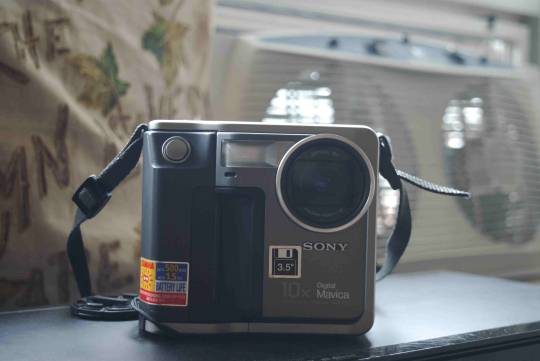
This is the Sony Digital Mavica FD-7, released in 1997!
Sony is probably more well known now for their line of professional mirrorless cameras, but back in the heyday of digital photography, Sony was doing some strange, strange things.
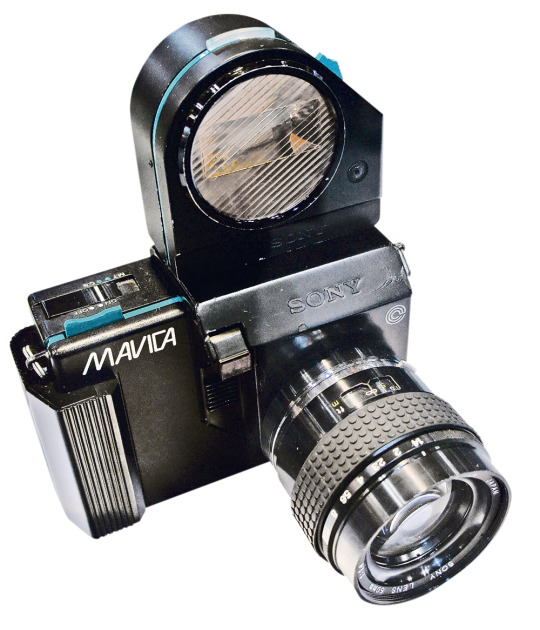
The history of Sony's ventures into digital photography has been covered extensively on the internet, so I won't go into it much, other than the quick facts. In 1981, the first product of theirs to bear the Mavica name was a prototype Still Video Camera from 1981. Still Video Cameras are a whole other can of worms as well (and one I really really want to get into when I inevitably come into possession of one). Mavica stood for MAgnetic VIdeo CAmera. The photos, which were just still frames taken from video were stored on these:
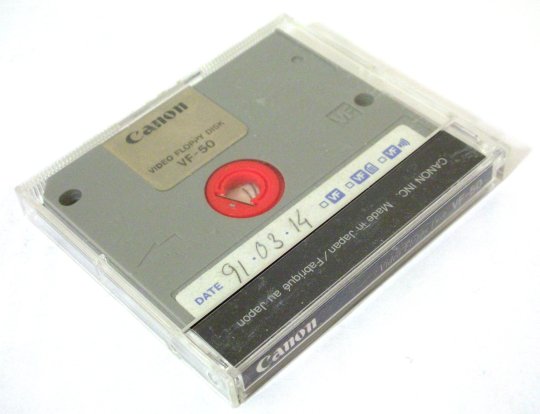
VFDs, or Video Floppy Disks. Again, this is a whole other beast when it comes to the history of digital photography. Sony manufactured a few of these Still Video Cameras under the Mavica line in the 1980s. Eventually this product line was discontinued, but Sony resurrected the Mavica name for a long-running series of floppy disk (and later CD) based cameras in the mid 1990s and 2000s.
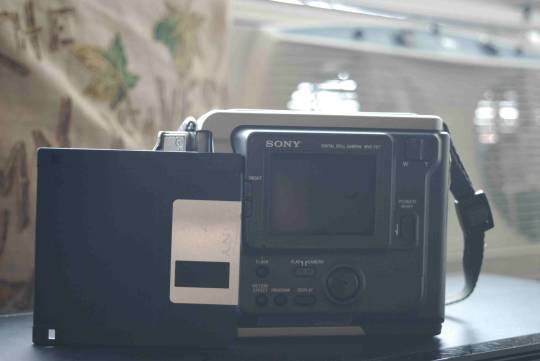
The FD-7 was part of the first run of Sony's Digital Mavicas, along with the FD-5, pictured below, which was the lower end model with a fixed focus lens.
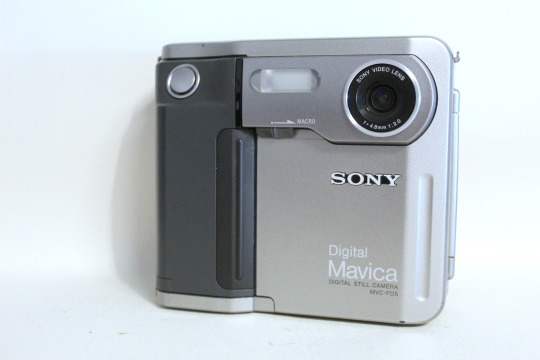
The FD-7 was the higher end model with a much larger lens, a 4.2-42mm f1.8, and has a 10x optical zoom. Both stored their images, as shown above, onto floppy disks.

You could store about 40 or so images in the camera's Standard mode, and about 20 in Fine mode, which for the time and the storage medium was pretty respectable. Floppy disks were everywhere at the time, so there really wouldn't have been any issue in terms of running out of storage.
One other quirk of these cameras I'd like to address are the Field/Frame modes. The Mavicas are actually doing something sort of clever here. The image sensor inside is still one used for video.

If you look at this image I've taken, you can see there's an after-image left behind on it. This is a result of the camera's sensor. The Field/Frame option does...something...that I think reduces the effect (Honestly Clint from LGR's video on this is where you should go for the technical details https://www.youtube.com/watch?v=3Nu6C-Ci7_Q)
ANYWAY. With all of that out of the way, here are some of the shots I've taken! (As with a LOT of digital cameras from around this time, the FD-7 shoots in 640x480 resolution, with quality modes delineating the amount of compression the image is given. All of these shots were taken in Fine mode.)

(This camera has a very good macro mode, btw!)





And there you have it! Honestly, I may just forego the rating portion of these after the first one. I want my concluding thoughts to be more interesting than a bunch of numbers.
If you like the challenges shooting with a low resolution and on a non-standard memory format, pick one of these up! USB floppy drives can be found for really cheap, and you can just drag and drop them from the disks right on to your computer, no fiddling required. I will say though, as a warning, that this stuff is nearing 30 years old. I actually have two of the FD-7s because my first one failed and refuses to focus in any way. Floppy disks can also be a problem, as I've had certain ones fail to record images due to bad sectors.
Other than that, these cameras feel surprisingly good in the hands, despite their boxiness, and are generally just really fun cameras to use. I have some of the later Mavicas, and while their image quality is better, (with the caveat that you can store much less images per disk) the original has this charm to it. It was the first of a series of really odd cameras that feel alien compared to today's camera market. And just for that, I think it's so cool.
4 notes
·
View notes
Text
What is the Best Touchless Kitchen Faucets?
Are you looking for the perfect touchless kitchen faucet that will make your kitchen experience more enjoyable and convenient? Touchless kitchen faucets are becoming increasingly popular due to their sophisticated technology, as well as being energy-efficient and cost-effective. In this blog post, we're going to explore why touchless kitchen faucets are an ideal choice for any homeowner, and offer some of our top picks for the best touchless kitchen faucets on the market. Read on to discover all you need to know about choosing your new dream tap.
If you want to know more. Let's read on topic Best Touchless Kitchen Faucets
What are touchless kitchen faucets and why should you get one?

Touchless kitchen faucets are a type of sink faucet that allow you to control the water flow without having to use an actual handle. Instead, they use sensors or motion detectors that turn the water on and off when it detects movement nearby. This makes them incredibly convenient as you don't need to touch anything with your hands, which is great for avoiding the spread of germs in your kitchen. Touchless faucets are also energy-efficient since they turn off on their own after a certain period of time without use, saving water and money in the long run.
Benefits of having a touchless kitchen faucet
In addition to the convenience and health benefits of having a touchless faucet, there are several other advantages that make them worth investing in. They require very little maintenance since they have fewer parts than traditional faucets and don't need to be manually operated. Many also come with advanced features like temperature control, so you can easily adjust the water temperature to your liking. They also tend to be more aesthetically pleasing than traditional faucets, making them a great choice for modernizing any kitchen.
How to choose the best touchless kitchen faucet
When it comes to choosing the best touchless kitchen faucet for your needs, there are a few things to consider. First, think about what type of finish you would like; brushed nickel is popular due to its durability and modern look, while chrome is great for a more traditional style. You should also check that the sensors in the faucet work well and are quick to respond; this will ensure that the water turns on and off as soon as you move your hand away from the faucet. Finally, look for a faucet with adjustable settings so that you can easily adjust the pressure, temperature, and flow of water.
Top 5 touchless kitchen faucets on the market
Now that you know what to look for when buying a touchless kitchen faucet, here are some of our top picks for the best ones on the market.
Moen Arbor Motionsense: This faucet uses motion-sensing technology to turn water on and off with ease, and it's adjustable so you can control water flow and temperature with the touch of a button.
Delta MagnaTite Docking: This high-end faucet has a magnetic docking system that keeps it securely in place, plus an LED light indicator for easy operation.
Kohler Sensate Touchless Faucet: This modern-looking faucet is equipped with a voice-activated system and adjustable settings.
American Standard Selectronic: This touchless faucet uses a hands-free sensor to turn on the water, plus it has an extended spout so that it can easily reach any sink or bowl.
Moen Align Motionsense Wave: This high-end faucet has an extended reach and uses a wave-activation technology to turn water on and off.
Each of these faucets is sure to bring sophistication and convenience to your kitchen, so be sure to do more research on each one before making the final decision. With the right touchless kitchen faucet in place, you're well on your way to a more enjoyable and efficient kitchen experience.
So if you're ready to upgrade your kitchen with the latest technology, consider investing in one of these top touchless kitchen faucets! With the convenience they offer and their energy-efficient design, you'll be sure to get great use out of them for years to come.
Tips for properly installing a touchless kitchen faucet
Installing a touchless kitchen faucet may seem like a daunting task, but it's actually quite simple and straightforward. First, you'll need to turn off the water supply at the shutoff valve underneath your sink and then disconnect the old faucet. Then, follow the instructions that come with your new faucet and attach it to the sink. Make sure to seal all connections with plumber's tape and then turn on the water supply again. Finally, test out your new faucet by turning it on and off with motion sensors or voice control technology until you're satisfied with its performance.
Installing a touchless kitchen faucet is a great way to upgrade your kitchen and save time and energy. With a few simple steps, you can quickly start enjoying the convenience of a hands-free faucet.
Conclusion
Touchless kitchen faucets are becoming more and more popular due to their convenience, energy-efficiency, and modern design. If you're looking to upgrade your kitchen with the latest technology, investing in a touchless faucet is a great option. Be sure to carefully research your options before making a selection so that you can get the best faucet for your needs. And don't forget to follow the proper installation steps to ensure that your faucet is up and running smoothly. With the right touchless kitchen faucet in place, you're sure to make your kitchen more efficient and enjoyable!
Frequently asked questions about touchless kitchen faucets
Are touchless kitchen faucets energy efficient?
Yes, touchless faucets are energy-efficient since they automatically turn off after a certain period of time without use, preventing water from needlessly running and saving you money in the long run.
Are touchless kitchen faucets expensive?
The price of a touchless kitchen faucet depends on the features and quality of the product, but generally speaking they tend to be more expensive than traditional faucets. However, due to their energy-saving capabilities and long-term durability, they are well worth the investment.
Are touchless kitchen faucets easy to install?
Yes, touchless kitchen faucets are relatively easy to install as long as you follow the manufacturer's instructions and have basic plumbing knowledge. If you don't feel comfortable doing it yourself, then you can always hire a professional plumber to do the job for you.
2 notes
·
View notes
Text
Magnetic Sensor Market Soars to New Heights: A Comprehensive Analysis by Future Market Insights, Inc. (2023)
The global Magnetic Sensor Market is on a rapid growth trajectory and is set to achieve a market size of US$ 2,382.91 million in 2023. This robust expansion is expected to continue, with an estimated Compound Annual Growth Rate (CAGR) of 4.9%, propelling the market to a value of US$ 3,844.70 million by 2033.
Request a Sample of this Report : https://www.futuremarketinsights.com/reports/sample/rep-gb-5217
Several important factors, such as the following, are driving the market for magnetic sensors:
The increasing demand for magnetic sensors in automotive applications The growing demand for consumer electronics The expansion of IoT and advancements in technology Increasing focus on safety and security The rising demand for automation
These drivers are creating opportunities for manufacturers and service providers to develop new and innovative force sensor solutions.
Companies can capitalize on these drivers by investing in research and development activities. Additionally, they are focusing on new application areas, and collaborating with industry partners to develop new force sensor solutions. However, the market also faces certain restraints, such as pricing pressure and concerns over material stability.
Some Opportunities in the Markets Include:
Development of customized force sensor solutions to meet specific application needs
Expansion into new and emerging application areas, such as healthcare and industrial automation
Adoption of advanced technologies such as artificial intelligence and machine learning for magnetic field sensors data analysis and processing
Increasing focus on environmental sustainability and the development of eco-friendly magnetic sensor solutions
Collaboration with industry partners to develop new force sensor applications and expand market reach
Some Threats Restraining the Market Include:
Competition from established magnetic sensor manufacturers and new market entrants
Fluctuating demand for magnetic sensors in certain industries, such as consumer electronics
Dependence on certain end-use industries, such as automotive and industrial automation, for revenue growth
Technological advancements in alternative sensor technologies, such as optical and acoustic sensors. This could potentially replace magnetic field sensors in certain applications
Challenges associated with maintaining quality and reliability standards in magnetic sensor production. Particularly in high-volume manufacturing environments.
Ask an Analyst : https://www.futuremarketinsights.com/ask-the-analyst/rep-gb-5217
Key Takeaways
The widespread adoption of magnetic sensors in emerging navigational aids and presence detection (building automation-related applications).
Increasing usage in healthcare, and transportation sectors, among others, is changing the global magnetic sensors market.
Several end-user industries are beginning to adopt magnetic field sensors due to rising global demand for the Internet of Things (IoT). As well as the production of consumer electronics, electric and hybrid vehicles, and high-quality sensing devices.
The global market for magnetic sensors is being pushed forward by the rising demand for safety applications. This is caused by the rising popularity of robotics in factory automation because of Industry 4.0 policies. As the country’s services industry expands and the count of data centers and cloud service providers proliferates. It is predicted that there may be a greater need for these sensors in PDU.
Recent COVID-19 outbreaks, however, are having an impact on both demand and supply in the semiconductor industry. The semiconductor and electronics industries are dominated by Asia Pacific nations like China, Taiwan, and South Korea.
What are the Competitors in Magnetic Sensor Market Doing?
Infineon Technologies AG
Infineon Technologies AG bought Cypress Semiconductor Corporation in April 2020. A United States-based semiconductor design and manufacturing. To expand its power semiconductors, automotive microcontrollers, sensors, and security solutions portfolio. Furthermore, the company focuses on meeting the needs of ADAS/AD, IoT, and 5G mobile infrastructures.
Melexis
Melexis introduced a high-linearity, low-drift linear Hall sensor IC in March 2020. For safety-critical automotive torque-sensing applications including electric power-assisted steering (EPAS).
Allegro MicroSystems
Allegro MicroSystems, LLC launched the ATS19580, a fully integrated, back-biased GMR transmission speed and direction sensor, in February 2020. This sensor minimizes system size, complexity, and costs, which leads to better fuel economy.
Request for Methodology: https://www.futuremarketinsights.com/request-report-methodology/rep-gb-5217
Key Players in the Market
Texas Instruments
Diodes Incorporated
STMicroelectronics, Inc.
Analog Devices
Honeywell International Inc.
Asahi Kasei Corporation
TE Connectivity Ltd
Key Segments
By Product Type:
Magnetic Sensor Test Kits
Transcription-Mediated Amplification (TMA)
Polymerase Chain Reaction (PCR)
Ligase Chain Reaction (LCR)
Whole Genome Sequencing
Consumables
By Indication:
Infectious diseases
Cancer
Forensic Testing
Others
By End User:
Hospitals
Pathology laboratories
Research Institutes
Clinics
By Region:
North America
Latin America
Western Europe
Eastern Europe
Asia Pacific Excluding Japan
China
Japan
The Middle East and Africa (MEA)
0 notes
Text
i had to call him sensei!-chp 3
Today is a normal day like all other days. I was working on a special order for me. It is a gun that works on astermite stone instead of gunpowder. It fires bullets of electromagnetic waves instead of bullets of fire, and also with a trigger that is easy to pull and light in weight... I was working on it secretly as usual in The cellar, or rather, in the secret laboratory that the inventor and I built so that the hired thieves would not reach it, who became flocking to us more than the number of customers, so after we had a well-known reputation and also rumors about the extent of the ingenuity of our weapons and their lack of availability in the market, we have enemies who send thieves To steal inventions with special abilities, some of them are enemies of our customers who want to get rid of or take possession of the inventions of their enemies, and others just collect everything that is valuable and valuable that they have heard about...
Of course, we are the inventors. This is not a problem. We are the ones who create solutions to problems. Therefore, we have developed the security system for our laboratory and store. You cannot easily access the laboratory without knowing the secrets of our traps and how to enter the laboratory, otherwise the results will be dire. Also, the inventor has worked to apply to the government. By providing him with protection or special police services, by arresting every thief we caught and verifying who is behind his transmission, but it is still just a request. But the problem is that as we continue to be robbed, our traps are evolving, as well as the thieves' theft methods. Every time a more talented thief than the one before him comes, the matter becomes difficult for us. We do not want to invent a deadly security system that kills thieves. We just want to stop them, so we also resorted to drugs. And sometimes non-lethal poisons that actually have an antidote...
And so when I was working on that gun, the sauce sensor that we invented moved, and I knew there was another thief, and while I was hiding the new invention in safety, I realized I was late because that thief attacked me from behind with an electric weapon. I don't know if that was an electric dagger or what it is, but luckily I wear the protective armor against stab wounds, electric waves, and bullets. It is a costume of my design, but it was not made by me. Rather, it is a special request that I submitted to a fashion designer who works on strange orders like us...
Because of that armor, I was able to survive and I attacked him too using the crossbow that shoots magnetic arrows under you with the bow to form shocking electromagnetic waves, but he is a professional thief who confronted two out of three and while avoiding it turned the tables on me and escaped with the gun. It came at the perfect time, there must have been spies who knew when I started this invention so they could anticipate how long I could finish it, they've been watching me for a while to anticipate my production capabilities, I was about to finish it, only a few details left, I think Whoever sent it will present it to another inventor who works for him to complete it, since the final form is almost clear...
Agile, he can dodge all bullets and run between obstacles easily, but that's okay, since I woke up in this body, I realized that it's not like what I'm used to, it's super fast and very agile, and my sense of smell is now so strong that I feel Nauseous at times (this super sense awoke two days ago after I woke up in this body), so I could catch up with him and his scent, even doing moves I never dreamed I'd do (I guess the only acrobatic I still haven't done) She's standing on the ceiling...ha-ha). I continued chasing him through the alleys, and my breath began to break until he entered the Museum of Tire. The museum was full of visitors, which made it difficult to run and catch up with him, but I could still see him. I would not allow him to take my invention from me... That thief entered a dark and empty hallway. Then I followed him to him as hard as I could, so that his trace would not disappear from my sight, until I saw him entering a door that came at the end of the hallway, covered with a dark curtain.
A strange shape, as if the earth was moving or everything around me was moving, but I could not see anything. The situation continued in this way for a few moments, and I was slowly moving forward without knowing where I was going, until the vision suddenly became clear. The darkness suddenly cleared and the light blinded my sight. That's a big hall full of weird and interesting artifacts...but where is that thief!? where am I!? What happened!? Until I saw a shadow fleeing from behind one of the antiques, I followed him quickly, and then I was in another hallway full of doors. I did not know which door that thief entered, so I chose the door that had the smell of that thief. The people here are dressed in disguises and they look angry and they are screaming like they are crazy and there is also annoying music as if it is screaming what is that sound but...why is everyone here attacking others, wait a minute these people are not human they are vampires and they are all revolting. I ran away from that scene because it was too dangerous for me, so the thief kept running again before my eyes.
I caught up with him, and he disappeared again, damn him!! He keeps hiding from sight... While I was searching for him, someone fell in front of me, all covered in blood. He was injured!? Who hit him!? Is he a vampire?! And while I was amazed, the events did not stop developing quickly, one of them attacked me with a sharp weapon, I did not know what it was, but my body moved on its own and avoided it. ! I've never felt this way when I'm endangered by a vampire, a thief, or someone else... This person is dangerous! But the question that repeats itself, why am I so graceful and my body moves on its own? Is this the secret of the original owner of this body? Also, this person has the same smell as that thief! Is it personally I am now facing for the first time face to face !?
That person kept attacking me and my body avoided it until I scratched, what is wrong with this man!? Why is he targeting me!? Also not a rampaging vampire! His movements are deliberate and not barbaric! Was he really a vampire?! Because he's not like the vampires I've met! I got tired of this defensive position, I have to create a distance between us, or the blades of his claws will penetrate me, so I tried to find a loophole in his attack, so I hit him directly with his weapon, but I failed. Also, my sense of smell is now unique, I can even remember the smell of people). That person stepped back, and there were two other people, so they became three huge people dressed in black, he and the thief, and I think that thief was the one who killed that person, and the third was a confused person as if he was surrounded by a black mist and dark darkness, I could not distinguish his appearance, he was smiling a strange smile … It wasn't just the three of you in the hallway, there were two other people, a child and a dark man, but they weren't wearing black and they also looked worried about them, as if they were taking care!
What is this situation!? Can I escape!? But the boy and the man seem to be in trouble!? Also, I don't think that thief will leave me alone now! What would the person I sent gain from killing me? I have to find a way to get back, why did he lure me all the way here in the first place? And while I was at a loss, the shadow laughed and said: This is fun! I long to possess your real name..
real name? what is this! But the child and the man did not seem as perplexed as me, they knew what he meant. That shadow approached the brown man to whisper in his ear words that I could not hear, so the man shivered and started screaming suddenly, what did he say to him that made him panic!? And that shadow added, "What do you think I should take you where Louis is?" You will never feel lonely! And you'll get rid of your regrets, but in return I want your real name!
What is this name? And soon that man collapsed, the child remained motionless, and fear invaded his features and paralyzed his movement, so one of those two black men attacked the child!!! What do I do? Should I take advantage of the situation and run away? But that child will be cut to pieces! What do I do!? Although I was immersed in thinking, my body moved on its own to save that child, it is not in my favor and I have nothing to do with it, but I could not let him die and leave...
#august ruthven#lord ruthven#the book of vanitas#the case study of vanitas#les memoires de vanitas#memoir of vanitas#noe archiviste#vanitas no carte#vanitas x jeanne#vanitas x reader#vanitas fanart#vanitas manga#vanoe#vanitas icons#vampire
2 notes
·
View notes
Text
AGV Market Outlook 2031: Growth, Challenges, and Opportunities

Automated Guided Vehicles (AGVs) are transforming how businesses manage logistics and material handling. These self-guided machines are designed to move products, materials, or equipment within facilities without human intervention. From manufacturing plants to e-commerce warehouses, AGVs are streamlining operations, cutting costs, and improving efficiency. With rapid advancements in technology and rising demand for automation, the AGV market is on a significant growth trajectory.
What Are Automated Guided Vehicles?
AGVs are robotic material-handling systems powered by sensors, cameras, and software to navigate predefined paths. These vehicles are used in diverse industries, including manufacturing, warehousing, and logistics, to move goods across facilities with precision and minimal errors. By using technologies like laser guidance, magnetic strips, or GPS, AGVs operate autonomously without requiring a driver. Businesses rely on AGVs to boost productivity while reducing labor costs and workplace accidents.
Types of AGVs
AGVs come in different forms depending on their functionality and use cases:
Tow Vehicles: Designed to pull carts or trailers, these are commonly used for moving heavy loads across warehouses or factory floors.
Unit Load Carriers: Ideal for transporting smaller loads on pallets or trays. These AGVs are efficient in sorting and transporting goods within confined spaces.
Forklift AGVs: Robotic forklifts that can pick up, transport, and place pallets without human intervention. Perfect for warehouses and distribution centers.
Assembly Line AGVs: Used in manufacturing settings, they transport components between workstations to support production workflows.
Key Functions and Capabilities
AGVs boast several capabilities that make them indispensable in industrial environments:
Precise Navigation: Using sensors and advanced mapping systems, AGVs travel through facilities safely and accurately.
Load Transportation: AGVs handle goods ranging from lightweight packages to heavy items with ease.
System Integration: Seamless integration with warehouse management systems ensures efficient inventory tracking and replenishment.
Real-Time Monitoring: Most AGVs are equipped with software for 24/7 monitoring, enabling managers to track performance and address issues quickly.
Market Drivers and Growth Trends
Increasing Adoption of Automation in Industries
The shift toward industry automation is a significant factor driving AGV adoption. Businesses are under constant pressure to improve efficiency and reduce operational costs. AGVs are a perfect solution that provides consistent performance, minimizes errors, and reduces dependency on human labor. In industries like automotive, electronics, and pharmaceuticals, AGVs are being used to streamline production and distribution processes.
Advancements in AGV Technologies
Technologies like artificial intelligence (AI), machine learning, and the Internet of Things (IoT) are unlocking new possibilities for AGV applications. AI-powered AGVs can learn and adapt to new environments, while IoT connectivity ensures they operate as part of a broader, interconnected ecosystem. Navigation improvements, such as LiDAR and vision-based systems, are enhancing the precision and flexibility of these vehicles. As these technologies mature, AGVs are becoming smarter, faster, and more capable than ever.
Rising Demand in E-Commerce and Warehousing
The surge in e-commerce has fueled an unprecedented need for efficient warehousing solutions. Companies are scrambling to keep up with customer expectations for fast delivery, and AGVs have become a crucial component of modern supply chains. By automating repetitive tasks like sorting, picking, and transporting goods, AGVs enable warehouses to handle increased volumes without scaling labor.
Market Outlook for Automated Guided Vehicles (AGVs)
The Automated Guided Vehicle (AGV) market is experiencing robust growth due to increasing demand for automation across industries. In 2021, the global AGV industry was valued at US$ 2.13 billion. With a projected compound annual growth rate (CAGR) of 13.11% from 2022 to 2031, the market is expected to reach US$ 7.96 billion by the end of 2031.
Challenges Facing the AGV Market
High Initial Investment Costs
One of the largest barriers to AGV adoption is the steep upfront cost. Small and medium-sized enterprises (SMEs) often find it difficult to justify the investment, even with long-term cost savings. Expenses related to AGV systems often include not just vehicle costs but also infrastructure upgrades and software implementation.
Integration and Scalability Issues
Adopting AGVs isn’t always seamless. They need to be integrated into existing workflows, which may require significant adjustments in infrastructure and processes. Furthermore, ensuring that AGVs can scale as business operations grow can pose additional challenges.
Maintenance and Technical Expertise
Like any advanced technology, AGVs require regular maintenance to perform at optimal levels. Companies also need skilled technicians who can troubleshoot and fix issues when they arise. For businesses without in-house expertise, this reliance on external support can result in higher ongoing costs.
Future Outlook for the AGV Market
Emerging Markets and Global Expansion
While developed markets currently dominate AGV adoption, emerging economies are beginning to follow suit. Growing industrialization in countries like India, Brazil, and Mexico is driving demand for advanced logistics solutions. As automation technology becomes more affordable, we can expect AGV adoption to spread further across the globe.
Focus on Sustainable and Energy-Efficient AGVs
Sustainability is becoming a top priority in industrial processes. Manufacturers are increasingly focusing on energy-efficient AGVs that minimize electricity consumption and reduce carbon footprints. Battery innovations, such as lithium-ion technology, are also expanding AGV operating times while lowering environmental impact.
Integration with Smart Factories and Industry 4.0
AGVs play a critical role in the evolution of Industry 4.0, where factories become smart, interconnected systems. By linking AGVs with other automated systems like robotics and smart sensors, businesses can create fully integrated supply chains. This will enable facilities to respond quickly to demand fluctuations and optimize operations.
Emerging Trends in the AGV Industry
Collaborative AGVs (CoBots): AGVs are increasingly designed to work alongside human workers, enhancing productivity while maintaining safety.
5G and IoT Integration: The deployment of 5G networks will enable real-time communication between AGVs and centralized control systems, improving responsiveness and efficiency.
Autonomous Mobile Robots (AMRs): Unlike traditional AGVs, AMRs use AI-powered navigation to move freely without predefined paths, offering greater flexibility.
Conclusion
The Automated Guided Vehicle market is evolving rapidly, driven by the need for efficiency and technological breakthroughs. These robots are reshaping industries by improving productivity, meeting e-commerce demands, and supporting automation goals. However, challenges like high costs and technical complexities remain barriers businesses must navigate. Looking ahead, the AGV market holds immense promise with its potential to integrate into global smart factories and sustainable systems. As industries continue to innovate, AGVs will undoubtedly become a cornerstone of efficient and intelligent operations.
0 notes
Text
https://www.maximizemarketresearch.com/market-report/global-magnetic-field-sensor-market/66549/
0 notes
Text
On-Board Magnetic Sensor Market Geographical Expansion & Analysis Growth Development, Status, Recorded during 2017 to 2032
On-Board Magnetic Sensor Market at a CAGR of 8.6% During the Forecast Period 2023-2032.
The competitive analysis of the On-Board Magnetic Sensor Market offers a comprehensive examination of key market players. It encompasses detailed company profiles, insights into revenue distribution, innovations within their product portfolios, regional market presence, strategic development plans, pricing strategies, identified target markets, and immediate future initiatives of industry leaders. This section serves as a valuable resource for readers to understand the driving forces behind competition and what strategies can set them apart in capturing new target markets.
Market projections and forecasts are underpinned by extensive primary research, further validated through precise secondary research specific to the On-Board Magnetic Sensor Market. Our research analysts have dedicated substantial time and effort to curate essential industry insights from key industry participants, including Original Equipment Manufacturers (OEMs), top-tier suppliers, distributors, and relevant government entities.
Receive the FREE Sample Report of On-Board Magnetic Sensor Market Research Insights @ https://stringentdatalytics.com/sample-request/on-board-magnetic-sensor-market/2418/
Market Segmentations:
Global On-Board Magnetic Sensor Market: By Company • Asahi Kasei Microdevices • Infineon Technologies • TDK Corporation • Melexis NV • Sanken Electric • Murata Manufacturing • Honeywell International • TE Connectivity • Austria Mikro Systeme (AMS) AG • NXP Semiconductors N.V. • Sensoronix • Macome • Sensitec • Memsic • Kohshin Electric Global On-Board Magnetic Sensor Market: By Type • Hall Effect Sensors • Magnetoresistive Sensors • SQUID Sensors • Others Global On-Board Magnetic Sensor Market: By Application • Automotive • Consumer Electronics • Healthcare • Aerospace & Defense • Industrial • Others
Regional Analysis of Global On-Board Magnetic Sensor Market
All the regional segmentation has been studied based on recent and future trends, and the market is forecasted throughout the prediction period. The countries covered in the regional analysis of the Global On-Board Magnetic Sensor market report are U.S., Canada, and Mexico in North America, Germany, France, U.K., Russia, Italy, Spain, Turkey, Netherlands, Switzerland, Belgium, and Rest of Europe in Europe, Singapore, Malaysia, Australia, Thailand, Indonesia, Philippines, China, Japan, India, South Korea, Rest of Asia-Pacific (APAC) in the Asia-Pacific (APAC), Saudi Arabia, U.A.E, South Africa, Egypt, Israel, Rest of Middle East and Africa (MEA) as a part of Middle East and Africa (MEA), and Argentina, Brazil, and Rest of South America as part of South America.
Click to Purchase On-Board Magnetic Sensor Market Research Report @ https://stringentdatalytics.com/purchase/on-board-magnetic-sensor-market/2418/
Key Report Highlights:
Key Market Participants: The report delves into the major stakeholders in the market, encompassing market players, suppliers of raw materials and equipment, end-users, traders, distributors, and more.
Comprehensive Company Profiles: Detailed company profiles are provided, offering insights into various aspects including production capacity, pricing, revenue, costs, gross margin, sales volume, sales revenue, consumption patterns, growth rates, import-export dynamics, supply chains, future strategic plans, and technological advancements. This comprehensive analysis draws from a dataset spanning 12 years and includes forecasts.
Market Growth Drivers: The report extensively examines the factors contributing to market growth, with a specific focus on elucidating the diverse categories of end-users within the market.
Data Segmentation: The data and information are presented in a structured manner, allowing for easy access by market player, geographical region, product type, application, and more. Furthermore, the report can be tailored to accommodate specific research requirements.
SWOT Analysis: A SWOT analysis of the market is included, offering an insightful evaluation of its Strengths, Weaknesses, Opportunities, and Threats.
Expert Insights: Concluding the report, it features insights and opinions from industry experts, providing valuable perspectives on the market landscape.
Report includes Competitor's Landscape:
➊ Major trends and growth projections by region and country ➋ Key winning strategies followed by the competitors ➌ Who are the key competitors in this industry? ➍ What shall be the potential of this industry over the forecast tenure? ➎ What are the factors propelling the demand for the On-Board Magnetic Sensor? ➏ What are the opportunities that shall aid in significant proliferation of the market growth? ➐ What are the regional and country wise regulations that shall either hamper or boost the demand for On-Board Magnetic Sensor? ➑ How has the covid-19 impacted the growth of the market? ➒ Has the supply chain disruption caused changes in the entire value chain? Customization of the Report:
This report can be customized to meet the client’s requirements. Please connect with our sales team ([email protected]), who will ensure that you get a report that suits your needs. You can also get in touch with our executives on +1 346 666 6655 to share your research requirements.
Enquiry Before Buying @ https://stringentdatalytics.com/inquiry/on-board-magnetic-sensor-market/2418/
Our More Reports:
1. Global Digital Twin Financial Services and Insurance Market
2. Global Network Transformation Services Market
3. Global Used Goods Trading Platforms Market
About Stringent Datalytics
Stringent Datalytics offers both custom and syndicated market research reports. Custom market research reports are tailored to a specific client's needs and requirements. These reports provide unique insights into a particular industry or market segment and can help businesses make informed decisions about their strategies and operations.
Syndicated market research reports, on the other hand, are pre-existing reports that are available for purchase by multiple clients. These reports are often produced on a regular basis, such as annually or quarterly, and cover a broad range of industries and market segments. Syndicated reports provide clients with insights into industry trends, market sizes, and competitive landscapes. By offering both custom and syndicated reports, Stringent Datalytics can provide clients with a range of market research solutions that can be customized to their specific needs.
Reach US
Stringent Datalytics
+1 346 666 6655
Social Channels:
Linkedin | Facebook | Twitter | YouTube
#On-Board Magnetic Sensor Market Geographical Expansion & Analysis Growth Development#Status#Recorded during 2017 to 2032
0 notes